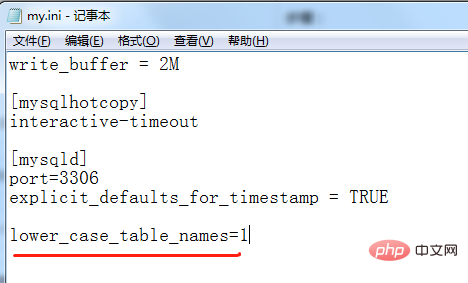How to make mysql case insensitive
How to make mysql case-insensitive: 1. Enter the installation directory of mysql, find and open the configuration file "my.ini"; 2. Add the "lower_case_table_names=1" statement to the last line of the configuration file , set the case-sensitive parameter "lower_case_table_names" to make mysql insensitive to case; 3. Restart the mysql service.

The operating environment of this tutorial: windows7 system, mysql8 version, Dell G3 computer.
How to make mysql case-insensitive
Mysql case-sensitive configuration is related to two parameters - lower_case_file_system and lower_case_table_names
lower_case_file_system: Indicates whether the current system file is case-sensitive (ON means insensitive, OFF means sensitive), a read-only parameter that cannot be modified.
lower_case_table_names: Indicates whether the table name is case-sensitive and can be modified.
The lower_case_file_system parameter cannot be modified, so the lower_case_table_names parameter can only be used to make mysql case-insensitive.
Steps:
1. Enter the mysql installation directory, find and open the configuration file my.ini

2. Add the following sentence to the last line of the configuration file
lower_case_table_names=1
lower_case_file_system indicates whether the file system where the data directory is located is sensitive to the case of the file name
0: Case-sensitive
1: Case-insensitive

3, Just restart the mysql service.
Note:
To set the default lower_case_tables_name from 0 to 1, you need to convert the existing library table name to lowercase first:
1) For the case where only uppercase letters exist in the table name:
①, when lower_case_tables_name=0, execute rename table to lowercase.
②. Set lower_case_tables_name=1 and it will take effect after restarting.
2) For the case where uppercase letters exist in the library name:
① When lower_case_tables_name=0, use mysqldump to export and delete the old database.
②. Set lower_case_tables_name=1 and it will take effect after restarting.
③. Import data into the instance. At this time, the library name containing uppercase letters has been converted to lowercase.
[Related recommendations: mysql video tutorial]
The above is the detailed content of How to make mysql case insensitive. For more information, please follow other related articles on the PHP Chinese website!

Hot AI Tools

Undress AI Tool
Undress images for free

Undresser.AI Undress
AI-powered app for creating realistic nude photos

AI Clothes Remover
Online AI tool for removing clothes from photos.

Clothoff.io
AI clothes remover

Video Face Swap
Swap faces in any video effortlessly with our completely free AI face swap tool!

Hot Article

Hot Tools

Notepad++7.3.1
Easy-to-use and free code editor

SublimeText3 Chinese version
Chinese version, very easy to use

Zend Studio 13.0.1
Powerful PHP integrated development environment

Dreamweaver CS6
Visual web development tools

SublimeText3 Mac version
God-level code editing software (SublimeText3)
 How to use check constraints to enforce data rules in MySQL?
Aug 06, 2025 pm 04:49 PM
How to use check constraints to enforce data rules in MySQL?
Aug 06, 2025 pm 04:49 PM
MySQL supports CHECK constraints to force domain integrity, effective from version 8.0.16; 1. Add constraints when creating a table: Use CREATETABLE to define CHECK conditions, such as age ≥18, salary > 0, department limit values; 2. Modify the table to add constraints: Use ALTERTABLEADDCONSTRAINT to limit field values, such as name non-empty; 3. Use complex conditions: support multi-column logic and expressions, such as end date ≥start date and completion status must have an end date; 4. Delete constraints: use ALTERTABLEDROPCONSTRAINT to specify the name to delete; 5. Notes: MySQL8.0.16, InnoDB or MyISAM needs to be quoted
 How to show all databases in MySQL
Aug 08, 2025 am 09:50 AM
How to show all databases in MySQL
Aug 08, 2025 am 09:50 AM
To display all databases in MySQL, you need to use the SHOWDATABASES command; 1. After logging into the MySQL server, you can execute the SHOWDATABASES; command to list all databases that the current user has permission to access; 2. System databases such as information_schema, mysql, performance_schema and sys exist by default, but users with insufficient permissions may not be able to see it; 3. You can also query and filter the database through SELECTSCHEMA_NAMEFROMinformation_schema.SCHEMATA; for example, excluding the system database to only display the database created by users; make sure to use
 How to add a primary key to an existing table in MySQL?
Aug 12, 2025 am 04:11 AM
How to add a primary key to an existing table in MySQL?
Aug 12, 2025 am 04:11 AM
To add a primary key to an existing table, use the ALTERTABLE statement with the ADDPRIMARYKEY clause. 1. Ensure that the target column has no NULL value, no duplication and is defined as NOTNULL; 2. The single-column primary key syntax is ALTERTABLE table name ADDPRIMARYKEY (column name); 3. The multi-column combination primary key syntax is ALTERTABLE table name ADDPRIMARYKEY (column 1, column 2); 4. If the column allows NULL, you must first execute MODIFY to set NOTNULL; 5. Each table can only have one primary key, and the old primary key must be deleted before adding; 6. If you need to increase it yourself, you can use MODIFY to set AUTO_INCREMENT. Ensure data before operation
 How to Troubleshoot Common MySQL Connection Errors?
Aug 08, 2025 am 06:44 AM
How to Troubleshoot Common MySQL Connection Errors?
Aug 08, 2025 am 06:44 AM
Check whether the MySQL service is running, use sudosystemctlstatusmysql to confirm and start; 2. Make sure that bind-address is set to 0.0.0.0 to allow remote connections and restart the service; 3. Verify whether the 3306 port is open, check and configure the firewall rules to allow the port; 4. For the "Accessdenied" error, you need to check the user name, password and host name, and then log in to MySQL and query the mysql.user table to confirm permissions. If necessary, create or update the user and authorize it, such as using 'your_user'@'%'; 5. If authentication is lost due to caching_sha2_password
 How to back up a database in MySQL
Aug 11, 2025 am 10:40 AM
How to back up a database in MySQL
Aug 11, 2025 am 10:40 AM
Using mysqldump is the most common and effective way to back up MySQL databases. It can generate SQL scripts containing table structure and data. 1. The basic syntax is: mysqldump-u[user name]-p[database name]>backup_file.sql. After execution, enter the password to generate a backup file. 2. Back up multiple databases with --databases option: mysqldump-uroot-p--databasesdb1db2>multiple_dbs_backup.sql. 3. Back up all databases with --all-databases: mysqldump-uroot-p
 Optimizing MySQL for Customer Relationship Management (CRM)
Aug 06, 2025 pm 06:04 PM
Optimizing MySQL for Customer Relationship Management (CRM)
Aug 06, 2025 pm 06:04 PM
TooptimizeMySQLperformanceforaCRMsystem,focusonindexingstrategies,schemadesignbalance,andqueryefficiency.1)Useproperindexingbyanalyzingfrequentqueries,addingindexesonWHEREclausecolumns,JOINkeys,andORDERBYfields,andconsideringcompositeindexeswheremult
 What is the difference between UNION and UNION ALL in MySQL?
Aug 14, 2025 pm 05:25 PM
What is the difference between UNION and UNION ALL in MySQL?
Aug 14, 2025 pm 05:25 PM
UNIONremovesduplicateswhileUNIONALLkeepsallrowsincludingduplicates;1.UNIONperformsdeduplicationbysortingandcomparingrows,returningonlyuniqueresults,whichmakesitsloweronlargedatasets;2.UNIONALLincludeseveryrowfromeachquerywithoutcheckingforduplicates,
 How to use the IN operator in MySQL?
Aug 12, 2025 pm 03:46 PM
How to use the IN operator in MySQL?
Aug 12, 2025 pm 03:46 PM
TheINoperatorinMySQLchecksifavaluematchesanyinaspecifiedlist,simplifyingmultipleORconditions;itworkswithliterals,strings,dates,andsubqueries,improvesqueryreadability,performswellonindexedcolumns,supportsNOTIN(withcautionforNULLs),andcanbecombinedwith







